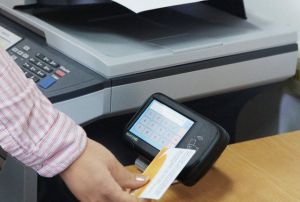
Pull printing System
Pull printing is a system where users select and release (pull) their print jobs when they arrive at the printer of their choice, rather than sending a print job from their PC (push) to a pre-specified printer or MFP (multifunction printer) for immediate printing. How does pull printing work? Unlike the more traditional push printing – where someone prints a document, and their PC (or the print server if one is in use), sends or pushes the job straight to the printer or MFP in question. The job prints immediately or as soon as it can be processed by the queue, and the owner collects it. This is the typical experience most people will think of when it comes to printing. Pull printing, by contrast, works as follows: someone sends a job to their printer as normal, but the Managed Print Software (MPS) system does not print it immediately – instead the job is stored in a queue in a secure database on the server. When the person arrives at the printer of their choice in order to collect their job, they have to authenticate with the MPS system, upon successful completion of which, the MPS system releases only that persons’ selected print job. The location of the printer is largely irrelevant: the software automatically directs the job to whichever printer the person has authenticated at. Authentication can be done in a variety of ways, from RFID cards to PINs or passwords, biometrics, QR codes or NFC. Many organizations already have magnetic or RFID physical access control systems in place, these existing cards can usually be used for pull printing authentication as well. Security and waste elimination When considering the effectiveness of pull printing, the fact that security surrounding printouts is substantially improved immediately becomes clear. Only an authenticated employee can collect a job, and they have to be physically standing in front of the printer before their job even starts printing. There are other significant benefits too, though, such as the fact that paper and toner wastage is dramatically reduced. Countless print jobs are certainly sent to the incorrect printers, or simply printed out and then forgotten on a daily basis in organizations everywhere. Preventing this wastage by implementing authenticated pull printing will add up to significant cost savings when taking economies of scale into account, not to mention the positive effects on the environment through the reduced paper, cartridges, toner, and energy wastage. What are the benefits of WeP secure pull printing? Secure, monitor and track all print, copy and scan tasks by user across an entire organization Eliminate waste of consumables – cartridges, toner and paper Use less energy Reduce printer numbers Improve efficiency of your print strategy Reduce printing costs Reduce overall cost of ownership Simplify print management Sentinel is compatible with printers, copiers, MFPs – multifunction printers from all the major brands of printer manufacturers including Toshiba, Brother, HP, Samsung, Ricoh, Sharp, Konica Minolta, Xerox, Lexmark, Develop, etc. Cloud Printing with WeP The nature of secure pull printing means that it is possible to send a job to print without knowing beforehand where you will collect it. Print jobs can be submitted from PC’s, laptops, mobile phones, tablets or any other mobile devices; they are then stored securely in a private queue on the Sentinel server or cloud. They can then be collected at any supported printer – whether in the room next door or a branch office on another continent. This is the power of WeP private cloud printing – hassle-free dynamic printing for users on the move. How Does WeP Private Cloud Pull-Printing Work? Send one or more documents to print. When you are ready to retrieve the printouts, identify yourself at a Sentinel printer by typing a PIN code on the printer or swiping a magnetic or RFID card. Once the Sentinel server recognizes you via your RFID employee card, ID card or PIN code, it will list all the print jobs waiting for you. Select a job to print, delete, view, hold, transfer to another printer, etc. The instruction is sent to the server for action. No one but you sees your documents. Because documents are only released to users after they input authorization information, sensitive documents are not left on output trays or picked up by the wrong person. The central Web-based server allows individual users to control their print jobs. The “follow me” feature allows users to transfer print jobs from one office printer to another by self-identifying at their device of choice. Your time will no longer be invested in connecting different servers and print server definitions for your many subsidiaries. The system becomes inherently more stable.
...more
Line Matrix Printer

Laser Printer Parts
Use WeP Traffic-less printing for branch offices to take advantage of WeP without a local server. For organizations with branch offices, Sentinel may be centralized and used in a traffic-less configuration. This method conserves Wide Area Network (WAN) bandwidth, which would otherwise be untenably high due to large-size print job traffic clogging it up. Traffic-less technology saves cost and maintenance overheads by allowing any number of branch offices to connect to a centralised WeP server without requiring an individual WeP server at each site, whilst ensuring that organisations and their branch users are still able to take full advantage of all WeP features, including pull printing, centralised print management, print reporting and more. How traffic-less printing works: The WeP server is configured at one central location; Branch client computers must have the WeP client application installed to support traffic-less printing; When an end user submits a print job at a branch office, the print job document itself is retained on the client PC, while the metadata (small unique summary information for each print job) is sent to and registered on the Sentinel server, much like an ordinary print job; The metadata is treated in the same way as a regular print job would be, by being held in the particular users print queue awaiting authentication; The user authenticates at a printer in their branch office, the WeP server releases the metadata, and the job itself is released by the client application from the PC and redirected to the printer in question, across the LAN, for printing. This technique ensures that print jobs, which can sometimes be hundreds of MB in size, do not leave the branch office Local Area Network (LAN), but rather just the metadata for each job. The metadata constitutes only a tiny amount of data compared to a full print job; this ensures that bandwidth across the WAN is preserved for other essential purposes. Advantages of traffic-less printing: Allows branch offices to take advantage of WeP functionality without requiring a server on site; Centralized server administration means lower cost and fewer maintenance overheads; No requirement for branch site servers means less IT support resources are needed for remote offices; WAN bandwidth usage is preserved. The only requirement for traffic-less printing is that the WeP client application must be installed on each remote branch client PC, and in most cases, a VPN connection will be required for full functionality. In certain cases, a VPN may not be required, though this may result in limited functionality.
...more
dot matrix printers

Computers Peripherals

Printer
Be first to Rate
Rate This